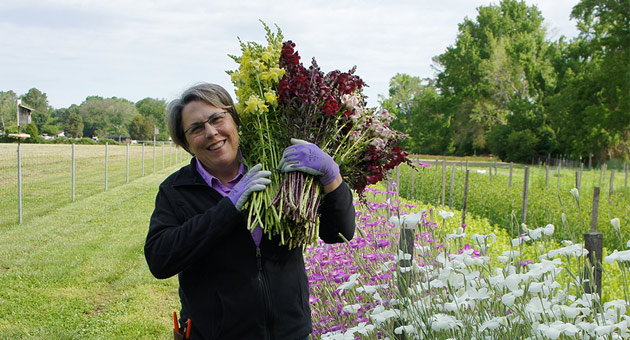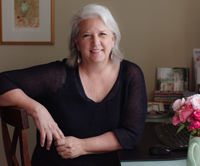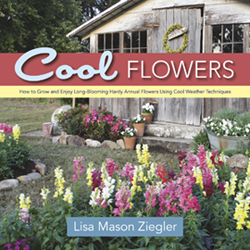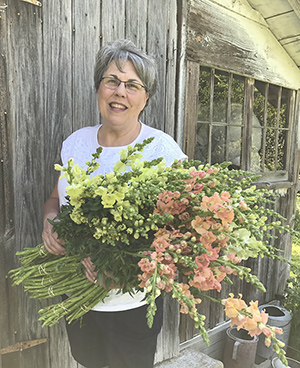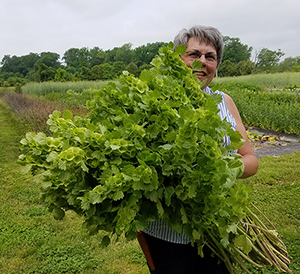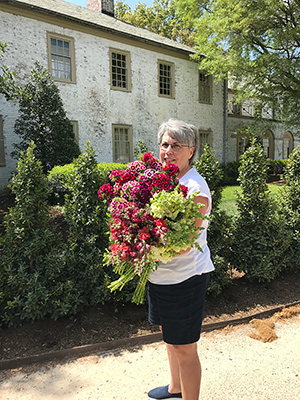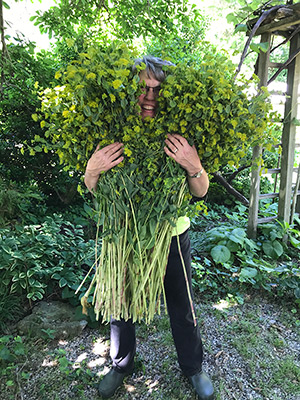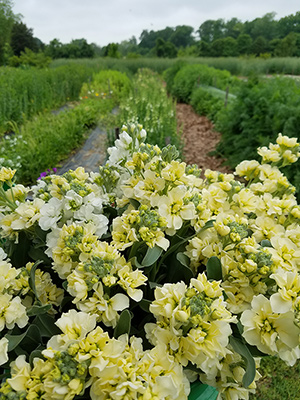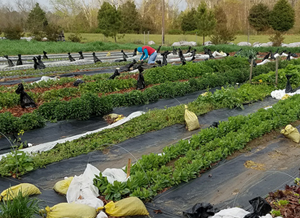- 3 Easy, Reliable, Productive Cut Flowers: Sunflowers, Zinnias & Rudbeckia
- 5 Factors That Determine Vase Life of Cut Flowers
- 2019 American Flowers Week: Combining the Art of Floral Design & Couture
- Celebrate the 7th American Flowers Week | Johnny's 2021 Botanical Couture
- Celebrating the 8th American Flowers Week | Johnny's 2022 Botanical Couture
- Collective Selling Models for Flower Farmers: Flower Hubs That Work
- 5 Cool Flowers to Plant Now | Lisa Mason Ziegler's Secrets for Growing Hardy, Cool-Season Annuals
- Cut-Flower Harvesting & Post-Harvest Care | Best Practices from Pros in the Slow Flower Community
- Cut-Flower Kit | Guide for Market Growers (PDF)
- Easy Cut-Flower Garden Map | For Growers New to Flowers (PDF)
- Easy Cut-Flower Garden Planner | For Growers New to Flowers (PDF)
- From Color to Climate: 5 Floricultural Trends Subtle & Seismic
- Flower Culture by Crop | Comparison Chart | Days to Germination, Weeks to Transplant, Days to Harvest (PDF)
- Flower Farmers' Favorite Fillers & Foliage | Recommendations from 3 Farmer-Florists
- Getting Started in Cut-Flowers | Top 15 Cuts
- Heat & Drought: How Flower Farmers Are Adapting to Changing & Challenging Climatic Conditions
- Introduction to Overwintering Flowers | Guide to Overwintering Flowers
- An Introduction to Producer Marketing Cooperatives | M Lund & Associates
- How Day Length Affects Cut-Flower Production
- Growing Flowers in Hoophouses & High Tunnels: Cool-Weather & Hot-Weather Options
- Starting a U-Pick Flower Farm, From A-to-Z
- Growing Flower Seedlings for Profit
- Roadside Flower Stand Basics: Success Tips for On-Farm Retail
- Year-Round Flower Production Strategy
- Overwinter Flower Trials | Multiyear Results for 30+ Crops | Johnny's Selected Seeds | XLSX
- Seeding Date Calculator | Johnny's Recommended Flowers for Overwintering | XLSX
- Pricing & Profitability for Flower-Farmers | Pointers from a Diversity of Pros
- Sustainable Farming Methods | A Survey of Flower Farmers' Best Practices
- Just Add Flowers | An Introduction to Companion Planting for Vegetable & Herb Gardeners
- Slow Flowers Palette & Petal Crushes | Evolving Colors & Shape-Shifts in Floral Industry Trends
- Johnny's and Slow Flowers | Johnny's Selected Seeds
- Slow Flowers | Celebrating Fifth-Season Regional Design Elements
- Slow Flowers Floral Forecast | A Summary of Industry Insights & Trends
- Building a Better Market Bouquet: Tips, Techniques & Recipes for Flower Farmers
- Slow Flowers | Tips for Staging On-Farm Floral Workshops | Johnny's Selected Seeds
- Wedding Wisdom 101 | 10 Beginner Tips for Entering the Wedding Floral Landscape
- Succession-Planting Flowers | Scheduling & Planning, Sowing Frequency, Recordkeeping & Recommendations
- Succession-Planting Interval Chart for Flowers
- Sustainable Floral Design | Techniques & Mechanics for Foam-Free Floristry | Tobey Nelson & Debra Prinzing
- Video: Mason Jar Bouquet Tutorial
- Video: How to Build a Bouquet
- Video: Tobey Nelson | Sustainable Floral Design | Slow Flowers Summit
- Video: Economic Considerations in Overwintering Cut Flowers | Johnny's Selected Seeds
- Top 10 Cut-Flower Varieties for Direct Seeding
- Video: Floating Row Cover | Baby "Cool Flower" Protection from Whipping Winter Winds
- Video: The Procona System for All-in-one Flower Harvest, Transport & Display
- Johnny's Overwinter Flowers Tunnel: Trellising, Supports, Ground Cover & Spacing
- Video: Irrigation Considerations for the Overwinter Flowers Tunnel | Johnny's Selected Seeds
- Video: Johnny's Overwinter Flowers Trial Recap
- Video: Producer Cooperatives for Small-Scale Farmers | Johnny's Webinar Series
- Climate Adaptation for Vegetable & Flower Farmers | Johnny's Educational Webinar Resources
- Chrysal CVBN Flower Conditioner | SDS
- Webinar Slide Deck | New-for-2023 Flowers & Floral Supplies | PDF
- Chrysal Clear Bulb Flower Conditioner | SDS
- Chrysal Professional 2 Transport & Display T-Bag | SDS
- Chrysal Classic Professional 2 Transport & Display (Holding) Solution | SDS
- Chrysal Clear Universal Flower Conditioner | SDS
- Webinar Slide Deck | Flower Growing in Southern States | PDF
- Choosing Flower Crops to Overwinter | Guide to Overwintering Flowers
- Edible Flowers List: Top 20 Favorites from the Slow Flowers Community
- Floral Standards for Flower Farm Collectives and Cooperatives
- Bloom to Boom: Flower Farm Profitability
- Choosing Tulip Varieties for Forcing | Guide to Forcing Flower Bulbs
- Forcing Tulip Bulbs | Guide to Forcing Flower Bulbs
- Snapdragon Groups Explained
- Flowering in the South: Profiles of 5 flower farmers who cope with temperature, humidity, pest & weed pressure
- Video: Flower Growing in Southern States | Johnny's Webinar Series
- 10 Tips for Building a Profitable Cut-Flower Business
- Introduction to Forcing Flower Bulbs in Soil | Guide to Forcing Flower Bulbs
- U-Pick Power for Your Flower Farm | Johnny's Webinar Series
- Eat Your Flowers: Serve Up That Wow Factor With Edible Flowers
- U-Pick Power for Your Flower Farm | Johnny's Webinar Series
- Flower Growing in Southern States | Johnny's Educational Webinar Series
- Chrysal Clear Bulb T-Bag | Cut-Flower Conditioner | SDS
- Chrysal Professional 1 Hydration Solution | SDS
- Chrysal Professional 3 Vase Solution Powder | SDS
- When to Start Seeds for Overwintered Flowers | Guide to Overwintering Flowers
- Webinar Slide Deck | U-Pick Power for Your Flower Farm | PDF
5 Cool Flowers to Plant Now (or very early next spring)
Learn Lisa Mason Ziegler's secrets for growing hardy, cool-season annuals
What is the definition of cool flowers?
Cool flowers, known as hardy annuals, live for one year and survive cold temperatures. Many are planted in the fall, to winter-over and produce blooms the following spring and summer. These flowers prefer becoming established and growing in cool conditions. Alternately, tender annuals live for one year and do not survive cold temperatures — they prefer to grow in the heat of summer. Both categories are annuals, but they are planted at very different times.
About Our Interviewee
At The Gardener's Workshop, an urban farm in Newport News, Virginia, Lisa Mason Ziegler has grown cut flowers since 1998. She farms intensively and organically on about 1½ cultivated acres of open field, producing 10,000 to 15,000 stems a week in season (mid-April to mid-November). She sells to upscale florists in both her town and nearby Williamsburg, and direct-to-consumers with a members-only Garden Share program for about 120 subscribers.
Lisa spends much of her off-the-farm time teaching others about organic gardening and growing cut flowers. Her lectures have reached from Texas to New York City — far beyond anywhere she ever imagined.
Lisa turned one of her favorite lecture topics — planting hardy annual flowers in the fall — into a book titled Cool Flowers, and has also published Vegetables Love Flowers, which is all about creating harmony between cut-flower gardens and organic vegetable gardens.
Cool Flowers explains how and when to plant hardy annuals successfully, either in fall or very early spring. As Lisa points out, once their needs are met, this diverse, easy-to-grow group of flowers will bloom weeks earlier than typical spring-planted annuals. And for flower farmers, that means you can bring beautiful flowers to market (and thereby generate income) just as early.
Any time of year is a good time to start planning your "cool flowers," Lisa says. I recently conducted this Q&A to learn more from this successful SlowFlowers member.
The Cool Flowers Philosophy
Lisa, after nearly two decades as a flower farmer, can you summarize your philosophy?
I love farming. I love being outside. I love being on a tractor. I have simplified my business model to better enjoy this journey of farming. I no longer grow what I love; I grow what sells week-after-week with the least amount of fanfare. I grow 40 different varieties throughout the season.
What do you grow, then?
I grow the basics — sunflowers, celosia of all hues and forms, including our favorite, Johnny's 'Sylphid'. I grow bells of Ireland and bupleurum. Lots of snaps, sweet William, sweet peas, and zinnias. I don't need to grow fussy ranunculus, because I'm not really interested in selling to wedding florists. Not only are weddings seasonal, but I don't want to work on Saturday and Sunday. That's why I gave up farmers' markets. I've always put my florist business first.
How many florists do you sell to, and how do you sell?
As I am moving towards semi-retirement, I've chiseled down from 23 commercial customers to only supplying 4 florists. They were my original customers and they buy everything. It takes me 15 minutes to sell the harvest of flowers because I just send them a list. They know my flowers; they know me; they just order what they want, and I don't have to explain or convince them. I'm selling to the people who use flowers day-in and day-out in their businesses.
Cool Flowers Tips & Techniques
Lisa protects her young flower plants from physical damage and desiccation with a layer of floating row cover, held in place with sand bags.
Over the years, then, how have you determined how to maximize your land to grow the best producers?
I grow almost exclusively annuals and do a lot of succession planting — annuals give the most bloom for the buck and the space. Spring is full of cool flowers — poppies and bells of Ireland and all those wonderful things. Then through summer, of course, we grow lisianthus; we try to have zinnias as early as possible and as late as possible. Of course, we try to have dahlias in the fall. I've learned to grow more volume of those flowers that we always seem to run short of.
How did you learn your "Cool Flowers" techniques?
I read and learned in Lynn Byczynski's book The Flower Farmer about how you can plant snapdragons in the fall. I looked for more hardy annuals to grow and took it from there because, of course, I had no hoophouses (I'm in the city, so I can't have them). So, I just started pushing field-grown hardy annuals to the limit. This technique is the best-kept secret in flower farming. It accounts for one third of my annual income in April, May and June — all field grown.
When do you plant cool flowers, and what types of flowers do you plant?
As a general guide, hardy annuals that survive your hardiness zone can be planted 6 to 8 weeks before the first frost in fall. They begin life from a seed, then winter-over as a young plant, becoming well-established so that when spring arrives, they quickly grow into a robust plant.
I've overwintered every hardy annual listed in Cool Flowers that is hardy to USDA Zone 7 and higher.
Because you are based in Zone 7, I would imagine flower farmers in colder Zones might think this approach wouldn't work for them.
What's coming to light now, especially for some Canadian flower farmers I'm counseling, is that they typically are not going to do fall planting in Zones 3 or 4. But cool flowers can be planted weeks before you would plant a warm-season tender annual in spring. I recommend planting 6 to 8 weeks before your last frost in spring.
Let's say your last expected frost is June 1 (that's when you'd be putting zinnias and sunflowers in the ground, for example). You can plant cool flowers up to 6 to 8 weeks before that date, which is anywhere between April 1 to April 15. As a result, you will get blooms so much earlier.
What are your planting techniques?
The key to early spring planting is preparing the beds in fall. I call it "very early spring," by the way, versus "late winter." When we plant in very early spring, which is Valentine's Day for us, we sweep the snow off prepared beds. I use biodegradable film and just wait for a sunny afternoon when the snow is starting to melt. Then I just sweep the beds and plant stock, sweet William, snapdragons, and others.
How do you prepare the beds?
We always spread a couple inches of compost of some kind, such as composted manure or leaf mold. Then we apply a dry organic fertilizer according to directions and incorporate that into the top 4 or 5 inches of the bed before planting. We use Bio360 biodegradable film and cover the beds, even the beds that aren't going to be planted until spring. With that black film on the ground through winter, the soil warms.
So you plant in fall and very early spring?
Yes, because it extends the harvest of those flowers.
How many hardy annual flower varieties do you grow?
I've grown all 30 cultivars in Cool Flowers. There is a quick reference in the book that lists all the cool flowers and the Zones to which they're known to be cold-hardy.
But for many of these flowers, there is no known documentation. So I list Zone 7, which is my Zone, because I know they not only survive, but thrive growing outdoors on my farm.
And, since the book first came out, I've heard from people in both Zone 5 and Zone 6 who have fall-planted in the field and using low tunnels with great success on some of those flowers that I listed hardy to only Zone 7.
Lisa's 5 Cool Flowers for Getting Started
If people want to try planting hardy annual flowers, what are your sure-fire varieties to start with?
I can suggest 4 that are included in Cool Flowers, plus a new, fifth one.
Snapdragons (Antirrhinum majus) should be started indoors and then transplanted. They are so cold-hardy. I have documentation up to Zone 4, so that's most of the country. I grow several varieties of snaps, with the 'Chantilly' and 'Madame Butterfly' Series topping the list.
Rudbeckia 'Indian Summer' (Rudbeckia hirta) should also be started indoors and then transplanted. They don't care how cold, how wet, how icy it is. When we plant 'Indian Summer' in the fall we sometimes have blooms by Mother's Day.
For direct sowing in the garden, I suggest bupleurum (Bupleurum griffithii) and larkspur (Delphinium consolida). And P.S. — I could grow two acres of bupleurum and still not have enough for my florists.
What is your newest addition to suggest?
Stock (Matthiola incana), the seeds of which should be started indoors before transplanting outdoors. I wasn't 100% sure about stock when Cool Flowers was published, but I have learned since that it does survive my Zone 7 garden when planted in the fall. In fact, it tried too hard to bloom at Christmas, so now we only plant in very early spring. We grow a ton of stock and plant it 8 weeks before our last expected spring frost. It's well below freezing at night, cold during the day, and stock performs beautifully.
By the way, it is the strongest germinating plant I have ever grown — super easy to start from seed. I love Johnny's 'Quartet' Series — and we can harvest by Mother's Day with this technique.
Thanks, Lisa! You've certainly given me confidence to try planting "cool flowers" this fall in my Zone 8 cutting garden.
More people should try this. Our grandmothers practiced this — they may not have done a lot of record-keeping, so we don't have precision Zone documentation for every variety, and zones and microclimates vary over the years. But this isn't a new thing. When researching for Cool Flowers I found a book that included planting hardy annuals published in 1951, The Better Homes & Gardens garden book!
When I teach flower farmers this technique, I offer this encouragement: "These plants are not afraid of the cold — so you needn't be, either!"
Learn More
Cool Flower Growing Info from Johnny's
1. Snapdragons
2. Rudbeckia
3. Bupleurum
4. Larkspur
5. Stock
Methodology
- Row Cover • Comparison Chart PDF
- Managing QuickHoops Visual Guide, by Eliot Coleman
- Mulches & Landscape Fabric • Comparison Chart PDF
- Hardiness Zone Map


